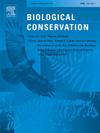Stressors affecting ecosystems can simultaneously impact ecological communities. Energy development and woody encroachment are two stressors that often occur concurrently but are rarely investigated together. We investigated changes in grassland and shrubland bird abundance in response to oil and gas development and woody plant cover in the Eagle Ford Shale of Texas in the south-central United States, an area that has experienced intensive oil and gas development in the 21st century. We used a multi-species distance sampling model to estimate abundance and community-level effects of energy development. We estimated both the magnitude and spatial scale of effect of each covariate on the grassland and shrubland bird community simultaneously within the same modeling framework. Oil and gas well pads had negative effects on all species abundances and these effects extended no greater than 1–2 km into the landscape. Oil and gas pipelines, however, had universally positive effects that extended up to 6 km into the landscape, likely because of ground cover management associated with installing and maintaining pipelines. The effect of woody cover was variable among species and extended 1–4 km into the landscape. Woody effects on individual species also varied among ecoregions, although this was likely a consequence of low woody density in some ecoregions. The varying spatial scales at which energy development and woody cover influenced abundance suggests that stressors are impacting different biological processes. Our results indicate that ecoregion-specific monitoring and inference is needed to accurately predict the impacts of environmental stressors on ecological communities.


